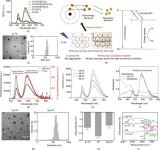(Press-News.org) COLUMBUS, Ohio – People who both vape and smoke are four times more likely to develop lung cancer than people who just smoke, according to new study published by The Ohio State University Comprehensive Cancer Center – Arthur G. James Cancer Hospital and Richard J. Solove Research Institute (OSUCCC – James) and College of Public Health. These findings were consistent across gender and race.
This is the first study to provide evidence that smoking in combination with vaping increases the risk for cancer compared to smoking alone. Researchers reported their findings in the Journal of Oncology Research and Therapy.
Study design and methods
Lung cancer is the leading cause of cancer-related deaths worldwide, resulting in 1.8 million deaths in 2020 alone. The American Thoracic Society has found that about 87% of these cancers can be directly linked to persistent tobacco smoking.
For this case-control study, researchers analyzed cigarette smoking and use of electronic cigarettes (also known as vaping) in 4,975 people with lung cancer compared to a control group of 27,294 people without cancer. All study subjects were from the same general geographic location (treated in Columbus, Ohio) and had the same distribution of age, gender and race.
Researchers found that vaping combined with cigarette smoking was eight times more common in people with lung cancer compared to the control group of people without lung cancer. In addition, the data showed that the risk of developing lung cancer was four times higher among people who combined vaping and smoking compared to those who only smoked.
“Our findings provide the first evidence that smoking in combination with vaping significantly increases the risk of lung cancer compared to smoking alone. Most people know that tobacco smoke contains cancer-causing chemicals but, overall, there is less knowledge about the chemicals that are inhaled through vape vapors,” said Randall Harris, MD, PhD, corresponding author of the study and professor of epidemiology in the College of Public Health.
Researchers say it is critical that regulators consider these additional health exposures in their regulation of the tobacco product industry to further protect public health, particularly when it comes to inhaled flavorings and nicotine dose concentrations.
“From a public health perspective, we have always been concerned about dual-use of both traditional and e-cig products. This study presents clear evidence showing that vaping in addition to smoking can increase your risk for lung cancer. This is especially concerning given the rate of youth and young adults using these products,” said lead author Marisa Bittoni, PhD, a researcher in the medical oncology division in the College of Medicine. “More research about the health effects of alternative tobacco products is critically needed to put science behind the regulation of the tobacco industry.”
This study was supported by a grant from the National Cancer Institute and the Richard B. Early Cancer Research Fund at The Ohio State University College of Public Health. David Carbone, MD, PhD, professor and director of the Thoracic Oncology Center at the OSUCCC – James, is also a coauthor.
Tobacco research at Ohio State
The OSUCCC – James is home to the Center for Tobacco Research, which brings together tobacco researchers from across the colleges of medicine, public health, law and nursing as well as the Ohio State Wexner Medical Center and the Comprehensive Cancer Center to conduct research on tobacco product use, regulation and health impact. The center is funded by the National Institutes of Health to provide critical research to inform the U.S. Food and Drug Administration’s evidence-based regulation of tobacco products through a Tobacco Center of Regulatory Science (TCORS) grant.
To learn more about research at the OSUCCC – James, visit cancer.osu.edu.
###
END
Vaping and smoking together increases lung cancer risk fourfold
2024-07-31
ELSE PRESS RELEASES FROM THIS DATE:
Scientists discover unexpected behavior in dimers of CO₂ molecules after ionization
2024-07-31
A team of international scientists has unveiled a surprising discovery in molecular physics, revealing unexpected symmetry-breaking dynamics in ionized carbon dioxide dimers. Published in Nature Communications, the study provides new insights into the structural changes that occur when these molecular clusters are exposed to extreme ultraviolet (EUV) radiation.
An international team of scientists, led by Profs. Daniel Strasser and Roi Baer from The Hebrew University of Jerusalem, has made an important discovery in molecular physics, revealing unexpected symmetry-breaking dynamics in ionized carbon dioxide dimers. Published in Nature Communications, ...
Cracking the carb code: Researchers create new glycemic index database to improve dietary awareness
2024-07-31
Karen Della Corte, BYU nutrition and dietetics professor, recently authored a new study, published in The American Journal of Clinical Nutrition, that developed a national glycemic index (GI) and glycemic load (GL) database to offer insights into the evolving quality of carbohydrates consumed in the United States, something that hadn’t been done previously.
The GI is a scale used by public health researchers to categorize the quality of the carbohydrates. High-GI foods like white flour and sugar cereals cause a “sugar rush” that can negatively impact metabolic health. ...
Military health research reveals potential pathway to reducing youth suicide
2024-07-31
Military-connected youth that show elevated risk for suicidal ideation and suicide plans exhibit lower rates of gun-carrying, according to new research from emergency medicine faculty at the University of Colorado School of Medicine.
The analysis, published in JAMA Network Open July 31 by members of the CU Center for Combat Medicine and Battlefield (COMBAT) Researchand Firearm Injury Prevention Initiative (FIPI), offers promising insight for potentially reducing gun-carrying among youths with recent suicidal ideation or plans. Researchers are also interested in how relevant strategies in military communities ...
Cannabinoid CBG reduces anxiety and stress in first human clinical trial
2024-07-31
PULLMAN, Wash. — A lesser-known cannabinoid that is gaining in popularity Cannabigerol (CBG) effectively reduced anxiety in a clinical trial without the intoxication typically associated with whole plant cannabis. It may even have some memory enhancing effects, according to a new study in Scientific Reports.
For the study, Carrie Cuttler, an associate professor of psychology at Washington State University, and colleagues conducted the first human clinical trial investigating the acute effects of CBG on anxiety, stress and mood.
The research revealed that 20 mg of hemp-derived CBG significantly reduced feelings of anxiety at 20, ...
University hospitals nationally recognized for high-quality stroke care
2024-07-31
CLEVELAND — University Hospitals (UH) has received numerous American Heart Association Get With The Guidelines® - Stroke quality achievement awards for ensuring stroke patients receive the most appropriate treatment according to nationally recognized, research-based guidelines, ultimately leading to more lives saved and reduced disability.
Stroke is the No. 5 cause of death and a leading cause of disability in the U.S. A stroke occurs when a blood vessel that carries oxygen and nutrients to the brain is either blocked by a clot or bursts. When that happens, part of the brain cannot get the blood and oxygen it needs, so ...
Humans are born to run
2024-07-31
The 2024 Summer Olympics are in full swing. One of the marquee events is of course the marathon, a grueling test of fitness and athleticism.
When it comes to endurance running, humans are among the very top mammals in their athletic prowess. While we may not be the best sprinters in the animal kingdom, we can run steadily for long distances, even in hot weather. Our locomotor muscles are dominated by slow-twitch, fatigue-resistant fibers and our unique ability to sweat allows our bodies to effectively dissipate heat.
Humans are so good at endurance running, it seems we were born to do it. But why?
A theory of endurance
In ...
Medicaid enrollees struggle to find psychiatric care
2024-07-31
Many people enrolled in Medicaid who require psychiatric care have difficulty accessing clinicians in a timely manner despite the higher need in this population, according to a study by researchers at Weill Cornell Medicine.
The results published July 31 in JAMA found that few psychiatrists and other mental health professionals who are listed as accepting new patients enrolled in Medicaid are actually reachable and have appointments available. In cases when appointments could be made, wait times sometimes extended up to six months. The research was conducted by first author Dr. Diksha Brahmbhatt (M.D. ’24), who is now a resident physician at Brigham and Women’s ...
Smithsonian scientists devise method to secure Earth’s biodiversity on the moon
2024-07-31
New research led by scientists at the Smithsonian proposes a plan to safeguard Earth’s imperiled biodiversity by cryogenically preserving biological material on the moon. The moon’s permanently shadowed craters are cold enough for cryogenic preservation without the need for electricity or liquid nitrogen, according to the researchers.
The paper, published today in BioScience and written in collaboration with researchers from the Smithsonian’s National Zoo and Conservation ...
Revolutionary x-ray-sensitizers could transform cancer treatment with low-dose radiation therapy
2024-07-31
Researchers at Xiamen University have made a significant advancement in cancer treatment by developing a novel class of X-ray-sensitizers (XSs) that could revolutionize radiotherapy. Published in Engineering, their groundbreaking study highlights how specific organic pharmaceutical drug intermediates, derived from thioxanthone (TX), can be activated by low-dose X-rays to efficiently generate singlet oxygen for targeted cancer therapy.
Traditional radiotherapy, a cornerstone in cancer treatment, often involves high doses of radiation (typically over 50 Gy), which can lead ...
ATMs and other digital self-serve devices fail to meet accessibility needs
2024-07-31
Most self-service interactive devices — kiosks, ATMs and other digital interfaces — don't measure up to the accessibility needs of Canadians who report to have a disability, a new study has found.
In partnership with the CSA Group (Canadian Standards Association), University of Waterloo researchers interviewed people with lived experiences of disability and received an overwhelming consensus that most self-serve devices have little to no accessibility features or they have trouble finding ...


